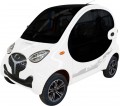Max. load
The maximum additional weight that a vehicle is designed to carry is, in fact, the weight of the payload that it is allowed to carry.
The maximum load includes both the passenger himself and the things he carries. In this case, the value is usually indicated based on a flat road and a quiet ride. So, ideally, it is best to have a maximum weight margin of at least 10-15 kg — this will give an additional guarantee in case of emergencies, such as a wheel falling into a pothole.
Range
The range of a vehicle is the distance it can travel on a single battery charge.
Note that the range usually indicates the value for perfect operating conditions: driving at optimal speed with a small load, flat road, no ups and downs, etc. The actual range may differ from the claimed one, sometimes quite noticeably. In addition, to improve range, manufacturers can deliberately use low-power motors that consume little energy.
Max speed
The highest speed that a vehicle can reach.
When choosing according to this parameter, it is worth considering that in dense city traffic, it is rarely possible to accelerate faster than 40 km/h; so if the vehicle is bought mainly for a comfortable ride through traffic jams, then there is no need to look for a high-speed model. In addition, for the same motor power, low speed means more torque, which makes it easier to climb hills.
Wheel size
tThe diameter of the wheels used in the vehicle. For models with wheels of different sizes, the largest diameter is usually indicated, other data can be specified in the notes.
For electric scooterbikes, the traditional size is a modest 10"; larger sizes are also found — up to
16". Among minibikes, large
18" wheels are more common. Electric motorcycles have small wheels — an average of 12 – 14". Among electric tricycles, a combination of a large front wheel with small rear wheels is often found — for example, 16 "and 4" each, respectively.
The large diameter allows you to roll over the bumps on the road, overcome rather large obstacles and maintain speed longer when coasting; on the other hand, such wheels require more torque from the engine, they accelerate worse and reduce the maximum speed of the unit. Small wheels, on the contrary, accelerate well and also provide good manoeuvrability, but they are intended mainly for flat roads.
Clearance
Vehicle clearance.
Clearance is the distance from the ground to the lowest point of the vehicle (excluding wheels). Roughly speaking, this is the highest height of an object that can fit under the vehicle without being hit the body.
The higher the clearance — the higher the obstacles that the unit can cope with, the lower the likelihood that when overcoming another pothole or bump, the body will touch the ground. On the other hand, low ground clearance lowers the centre of gravity and improves overall stability; so for roads with high-quality pavement and other flat surfaces, it is the smaller clearance that is considered optimal.
Wheelbase
Wheelbase of the vehicle.
This term shows the distance between the wheels, more precisely, between the axles of the wheels. This size is one of the key parameters for any motorcycle, it determines not only the overall dimensions of the vehicle but also some of the features of the movement. So, a small wheelbase reduces the turning radius and makes the vehicle more manoeuvrable; at the same time, a longer vehicle will be more stable and predictable in corners.
Full charge time
The time needed to charge the vehicle battery from 0 to 100%.
This parameter allows you to estimate what breaks you will have to take between trips to charge the vehicle. But keep in mind that a short charging time may mean a low battery capacity.
Separately, we note that in modern battery technology, “emergency” charging technologies can be used, which make it possible to partially replenish the energy supply in a very short time — for example, to charge a battery by 40% in an hour, which in normal mode would be fully charged in 8 hours.
Weight
The total weight of the vehicle without cargo and rider.
The
lighter the unit, the greater the range and, accordingly, the weight of the payload that can be carried on it. On the other hand, too little weight adversely affects the stability, and sometimes the overall strength of the structure.

